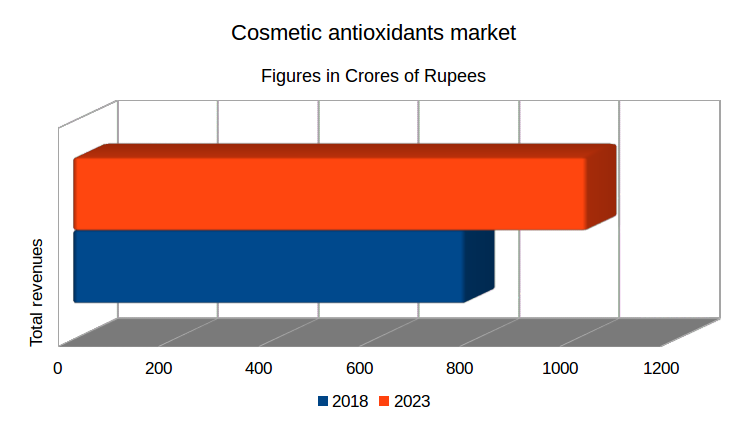Posting a healthy, 5.6 per cent growth, the worldwide cosmetics antioxidants market is estimated to reach $150.9 million by 2023 with Asia Pacific (APAC) emerging as the geography with the highest consumption
The worldwide cosmetic antioxidants market is forecasted to expand from $115.1 million (₹ 781.56 crore, approximately) in the current year to $150.9 million (₹ 1,024.65 crore, approximately) by 2023, according to a report published by MarketsandMarkets. This indicates a moderate 5.6 per cent growth annually.
Cosmetic antioxidants segment up-close
Amongst the world’s major geographies, the Asia Pacific (APAC) region has been the largest consumer of cosmetic antioxidants. It is expected to be the largest market for cosmetic antioxidants during the market-study period of 2018 to 2023. The growth of cosmetic antioxidants in APAC region can be attributed to the economic growth of emerging economies such as China, India, and Taiwan, among others. Increasing populations, improving the standard of living of masses, and the rapidly growing e-commerce sector have led to increased demand for cosmetic products in the APAC region, the MarketsandMarkets report mentions.
The top global companies operating in the cosmetics market include BASF (Germany), Koninklijke DSM (Netherlands), Wacker Chemie (Germany), Eastman Chemical Company (US), Lonza Group (Switzerland), Croda International (UK), Ashland Global Holdings (US), Evonik Dr. Straetmans (Germany), SEPPIC (France), BTSA Biotecnologías Aplicadas (Spain), Kemin Industries (US), and Barentz International (Netherlands), MarketsandMarkets reports.

The growth factors
The key demand drivers for cosmetic antioxidants are said to be the rising ageing population, increasing disposable incomes, and the changing consumer lifestyles. Within the cosmetic antioxidants category, much like last year, the vitamins segment is expected to spearhead the growth during the 2018 to 2023 period.
The vitamins that have been leading drivers of consumption in the cosmetic antioxidants category include vitamin E (tocopherols), vitamin C (ascorbic acid), and vitamin A (retinoid), among others. These are extensively used in cosmetic products due to their moisturizing and nourishment features.
All the important cosmetic products including for skin care, hair care, and decorative cosmetics make use of these vitamins.
Natural ingredients preferred
The factors contributing to the growth of the vitamins used in the cosmetic antioxidants space as observed in the year 2017 have been the rising demand for cosmetic antioxidants based on natural sources and a wide application base, according to the MarketsandMarkets report. Natural antioxidants are commonly used due to the rising demand for organic and herbal cosmetic products by consumers.
Synthetic antioxidants such as Butylated Hydroxytoluene (BHT) and Butylated Hydroxyanisole (BHA) are used in limited volume, as they are chemically derived ingredients. In western countries, cosmetic ingredients derived from chemical processes are strictly regulated and require COSMOS and ECOCERT certifications for application in cosmetics.
Going skin-deep
From the segments perspective, skincare application is likely to drive growth in the cosmetic antioxidants market during the forecast period as it did in the year 2017. The increasing consumer need for cosmetic products including anti-ageing creams, anti-wrinkle creams, and UV protection, particularly from the emerging markets, has been fuelling growth in sales in the skin care segment.

